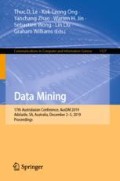Abstract
Measurement of population health outcomes is critical to understanding the health status of communities and thus enabling the development of appropriate health-care programmes for the communities. This task acquires the prediction of population health status to be fast and accurate yet scalable to different population sizes. To satisfy these requirements, this paper proposes a method for automatic prediction of population health outcomes from social media using Set Probabilistic Distance Features (SPDF). The proposed SPDF are mid-level features built upon the similarity in posting patterns between populations. Our proposed SPDF hold several advantages. Firstly, they can be applied to various low-level features. Secondly, our SPDF fit well problems with weakly labelled data, i.e., only the labels of sets are available while the labels of sets’ elements are not explicitly provided. We thoroughly evaluate our approach in the task of prediction of health indices of counties in the US via a large-scale dataset collected from Twitter. We also apply our proposed SPDF to two different textual features including latent topics and linguistic styles. We conduct two case studies: across-year vs across-county prediction. The performance of the approach is validated against the Behavioral Risk Factor Surveillance System surveys. Experimental results show that the proposed approach achieves state-of-the-art performance on linguistic style features in prediction of all health indices and in both case studies.
Access this chapter
Tax calculation will be finalised at checkout
Purchases are for personal use only
References
Andreu-Perez, J., Poon, C.C.Y., Merrifield, R.D., Wong, S.T.C., Yang, G.-Z.: Big data for health. IEEE J. Biomed. Health Inform. 19(4), 1193–1208 (2015)
Blei, D.M., Ng, A.Y., Jordan, M.I.: Latent Dirichlet allocation. J. Mach. Learn. Res. 3, 993–1022 (2003)
Culotta, A.: Estimating county health statistics with Twitter. In: Proceedings of the SIGCHI Conference on Human Factors in Computing Systems, pp. 1335–1344 (2014)
De Choudhury, M., Gamon, M., Counts, S., Horvitz, E.: Predicting depression via social media. In: Proceedings of the International AAAI Conference on Weblogs and Social Media (ICWSM), pp. 128–137 (2013)
Dittrich, J., Quiané-Ruiz, J.-A.: Efficient big data processing in Hadoop MapReduce. Proc. VLDB Endow. 5(12), 2014–2015 (2012)
Dredze, M.: How social media will change public health. IEEE Intell. Syst. 27(4), 81–84 (2012)
Dredze, M., Paul, M.J.: Natural language processing for health and social media. IEEE Intell. Syst. 29(2), 64–67 (2014)
França, U., Sayama, H., McSwiggen, C., Daneshvar, R., Bar-Yam, Y.: Visualizing the “Heartbeat” of a city with Tweets. Complexity 21(6), 280–287 (2016)
Ginsberg, J., Mohebbi, M.H., Patel, R.S., Brammer, L., Smolinski, M.S., Brilliant, L.: Detecting influenza epidemics using search engine query data. Nature 457(7232), 1012–1014 (2009)
Lan, R., Lieberman, M.D., Samet, H.: The picture of health: Map-based, collaborative spatio-temporal disease tracking. In: Proceedings of the SIGSPATIAL International Workshop on Use of GIS in Public Health, pp. 27–35 (2012)
Leetaru, K., Wang, S., Cao, G., Padmanabhan, A., Shook, E.: Mapping the global Twitter heartbeat: the geography of Twitter. First Monday 18(5) (2013)
Murphy, K.P.: Machine Learning: A Probabilistic Perspective. MIT Press, Cambridge (2012)
Nguyen, T., et al.: Kernel-based features for predicting population health indices from geocoded social media data. Decis. Support Syst. 102, 22–31 (2017)
Nguyen, T., et al.: Prediction of population health indices from social media using kernel-based textual and temporal features. In: Proceedings of the International Conference on World Wide Web Companion, pp. 99–107 (2017)
Parrish, R.G.: Peer reviewed: measuring population health outcomes. Prev. Chronic Dis. 7(4) (2010)
Pennebaker, J.W., Booth, R.J., Boyd, R.L., Francis, M.E.: Linguistic Inquiry and Word Count: LIWC 2015 [Computer software]. Pennebaker Conglomerates Inc. (2015)
Quercia, D., Capra, L., Crowcroft, J.: The social world of Twitter: topics, geography, and emotions. In: Proceedings of the International AAAI Conference on Weblogs and Social Media (ICWSM), vol. 12, pp. 298–305 (2012)
Schwartz, H.A., et al.: Characterizing geographic variation in well-being using tweets. In: Proceedings of the International AAAI Conference on Web and Social Media (ICWSM), pp. 583–591 (2013)
Shekhar, S., et al.: Spatiotemporal data mining: a computational perspective. ISPRS Int. J. Geo-Inf. 4(4), 2306–2338 (2015)
Thacker, S.B., Stroup, D.F., Carande-Kulis, V., Marks, J.S., Roy, K., Gerberding, J.L.: Measuring the public’s health. Public Health Rep. 121(1), 14–22 (2006)
Venerandi, A., Quattrone, G., Capra, L.: City form and well-being: what makes London neighborhoods good places to live? In: Proceedings of the SIGSPATIAL International Conference on Advances in Geographic Information Systems (2016)
Ye, M., Yin, P., Lee, W.-C.: Location recommendation for location-based social networks. In: Proceedings of the SIGSPATIAL International Conference on Advances in Geographic Information Systems, pp. 458–461 (2010)
Zaharia, M., et al.: Fast and interactive analytics over Hadoop data with Spark. Usenix Login 37(4), 45–51 (2012)
Author information
Authors and Affiliations
Corresponding author
Editor information
Editors and Affiliations
Rights and permissions
Copyright information
© 2019 Springer Nature Singapore Pte Ltd.
About this paper
Cite this paper
Nguyen, H., Nguyen, D.T., Nguyen, T. (2019). SPDF: Set Probabilistic Distance Features for Prediction of Population Health Outcomes via Social Media. In: Le, T., et al. Data Mining. AusDM 2019. Communications in Computer and Information Science, vol 1127. Springer, Singapore. https://doi.org/10.1007/978-981-15-1699-3_5
Download citation
DOI: https://doi.org/10.1007/978-981-15-1699-3_5
Published:
Publisher Name: Springer, Singapore
Print ISBN: 978-981-15-1698-6
Online ISBN: 978-981-15-1699-3
eBook Packages: Computer ScienceComputer Science (R0)

